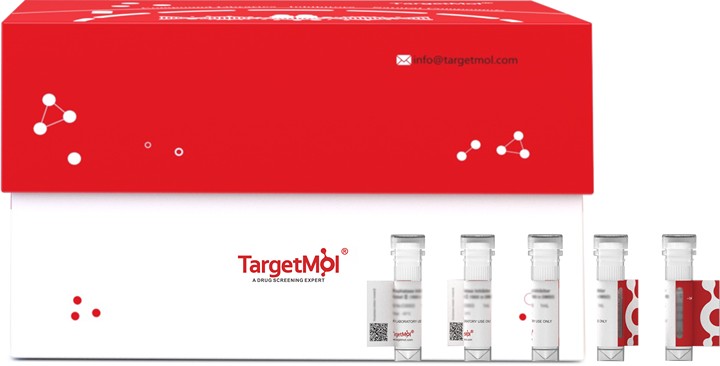- Remove All
 Your shopping cart is currently empty
Your shopping cart is currently empty
Shopping Cart
GLP1R Protein, Human, Recombinant (His & Avi)
Catalog No. TMPY-06864
Glucagon-like peptide (GLP)-1 receptor is encoded by GLP1R. GLP1R plays a critical role in mediating the biological actions of GLP1 in mammals and fish. The neuronal GLP1Rs mediate body weight and anorectic effects of liraglutide, but are not required for glucose-lowering effects. Glucagon-like peptide 1 receptor (GLP1R) signaling has been shown to have antipsychotic properties in animal models and to impact glucose-dependent insulin release, satiety, memory, and learning in man. Glucagon-like peptide-1 receptor (GLP1R) and glucose-dependent insulinotropic peptide receptor (GIPR) are their indirect drug targets.

GLP1R Protein, Human, Recombinant (His & Avi)
Catalog No. TMPY-06864
Glucagon-like peptide (GLP)-1 receptor is encoded by GLP1R. GLP1R plays a critical role in mediating the biological actions of GLP1 in mammals and fish. The neuronal GLP1Rs mediate body weight and anorectic effects of liraglutide, but are not required for glucose-lowering effects. Glucagon-like peptide 1 receptor (GLP1R) signaling has been shown to have antipsychotic properties in animal models and to impact glucose-dependent insulin release, satiety, memory, and learning in man. Glucagon-like peptide-1 receptor (GLP1R) and glucose-dependent insulinotropic peptide receptor (GIPR) are their indirect drug targets.
| Pack Size | Price | Availability | Quantity |
|---|---|---|---|
| 20 μg | $600 | 7-10 days | |
| 100 μg | $1,390 | 7-10 days |
Bulk & Custom
Add to Cart
Resource Download
Product Information
| Biological Activity | Activity testing is in progress. It is theoretically active, but we cannot guarantee it. If you require protein activity, we recommend choosing the eukaryotic expression version first. |
| Description | Glucagon-like peptide (GLP)-1 receptor is encoded by GLP1R. GLP1R plays a critical role in mediating the biological actions of GLP1 in mammals and fish. The neuronal GLP1Rs mediate body weight and anorectic effects of liraglutide, but are not required for glucose-lowering effects. Glucagon-like peptide 1 receptor (GLP1R) signaling has been shown to have antipsychotic properties in animal models and to impact glucose-dependent insulin release, satiety, memory, and learning in man. Glucagon-like peptide-1 receptor (GLP1R) and glucose-dependent insulinotropic peptide receptor (GIPR) are their indirect drug targets. |
| Species | Human |
| Expression System | HEK293 Cells |
| Tag | C-His-Avi |
| Accession Number | NP_002053.3 |
| Synonyms | glucagon-like peptide 1 receptor |
| Construction | A DNA sequence encoding the Human GLP1R (NP_002053.3) (Met1-Glu139) was expressed with a C-terminal polyhistidine tag followed by an AVI tag. The expressed protein was biotinylated in vivo by the Biotin-Protein ligase (BirA enzyme) which is co-expressed. Predicted N terminal: Arg 24 |
| Protein Purity | ≥ 95 % as determined by SDS-PAGE. ≥ 95 % as determined by SEC-HPLC. |
| Molecular Weight | 16.79 kDa (predicted); 35.91 kDa (reducing conditions) |
| Endotoxin | < 1.0 EU/μg of the protein as determined by the LAL method. |
| Formulation | Lyophilized from a solution filtered through a 0.22 μm filter, containing PBS, pH 7.4. Typically, a mixture containing 5% to 8% trehalose, mannitol, and 0.01% Tween 80 is incorporated as a protective agent before lyophilization. |
| Reconstitution | A Certificate of Analysis (CoA) containing reconstitution instructions is included with the products. Please refer to the CoA for detailed information. |
| Stability & Storage | It is recommended to store recombinant proteins at -20°C to -80°C for future use. Lyophilized powders can be stably stored for over 12 months, while liquid products can be stored for 6-12 months at -80°C. For reconstituted protein solutions, the solution can be stored at -20°C to -80°C for at least 3 months. Please avoid multiple freeze-thaw cycles and store products in aliquots. |
| Shipping | In general, Lyophilized powders are shipping with blue ice. |
| Research Background | Glucagon-like peptide (GLP)-1 receptor is encoded by GLP1R. GLP1R plays a critical role in mediating the biological actions of GLP1 in mammals and fish. The neuronal GLP1Rs mediate body weight and anorectic effects of liraglutide, but are not required for glucose-lowering effects. Glucagon-like peptide 1 receptor (GLP1R) signaling has been shown to have antipsychotic properties in animal models and to impact glucose-dependent insulin release, satiety, memory, and learning in man. Glucagon-like peptide-1 receptor (GLP1R) and glucose-dependent insulinotropic peptide receptor (GIPR) are their indirect drug targets. |
Dose Conversion
You can also refer to dose conversion for different animals. More
Sci Citations
Calculator
Tech Support
Please read the User Guide of Recombinant Proteins for more specific information.

Copyright © 2015-2025 TargetMol Chemicals Inc. All Rights Reserved.


